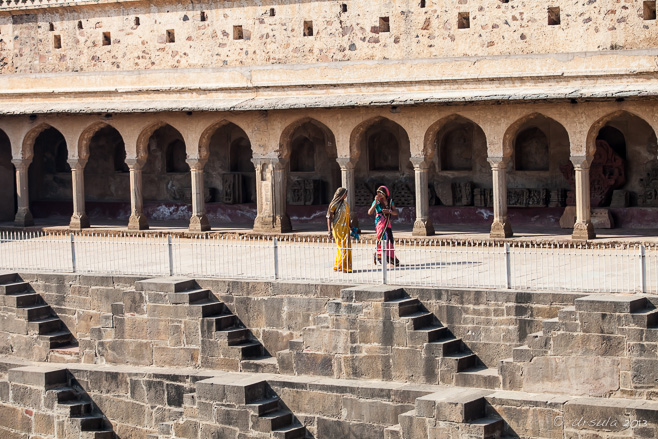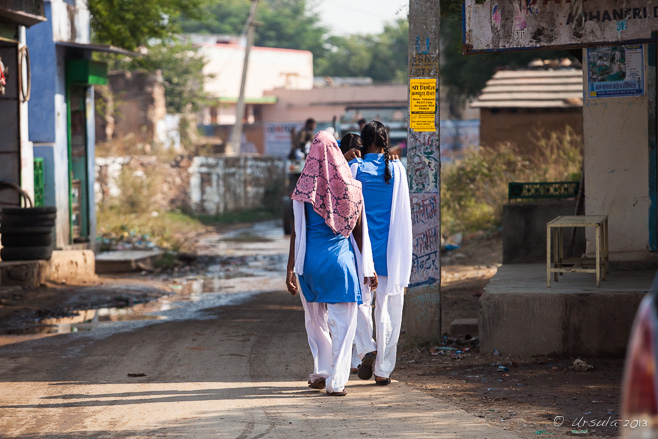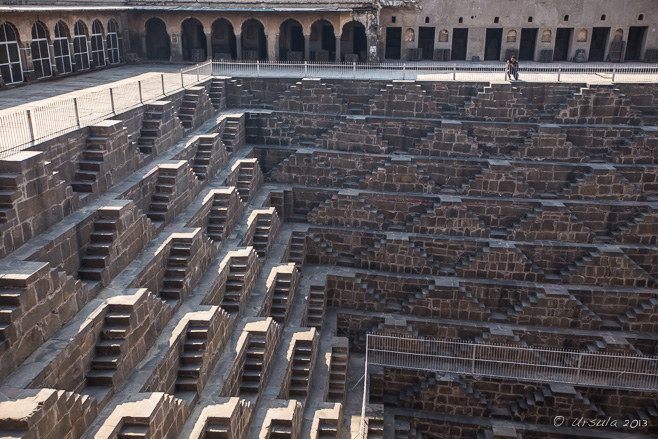
Women around the Stepwell
The Chand Baori stepwell, built between 800 and 900 AD, gives us a glimpse into Rajasthan’s past.
One of the pleasures of ground travel is the access you get to those places outside city centres. Ancient treasures and glimpses into the old ways of doing things can often be found just “off” the usual paths.
The ancient Rajasthani village of Abhaneri is only a fifteen minute detour off the main Jaipur – Agra highway. Abhaneri is home to a ruined tenth-century temple to Harshat Mata, Hindu Goddess of Joy and Happiness – and home to one of India’s largest and deepest remaining stepwells.
Stepwells. If you have never heard of them, you can be forgiven!
When I was doing background research on the Chand Baori stepwell in Abhaneri, I came across one site that called it “famous”. And, according to Wikipedia it was featured in the movie Paheli. I had to look that up as well: turns out it is a Bollywood film from 2005. Famous, perhaps – but not in my usual sphere.
Another useful website I found was entitled: India’s Forgotten Stepwells. So, not so famous after all! I’d seen pictures of women in saris against the Escherian-like steps leading into the well’s bottom – but I’ve never given the architecture or the purpose much thought.
Stepwells are found in arid regions of South Asia, extending into Pakistan, but are most common (according to Wikipedia) in western India. They were built to help solve the problem of having an unpredictable water supply in regions with long periods of dry heat, alternating with weeks of monsoonal rain. Surface water evaporates quickly in the dry season, and regular wells made water hard to access when the water levels dropped dramatically.
I had never seen a stepwell before, and was keen to visit this well-preserved example of Indian architecture.

Girls Going to School
It always amazes me how crisp and clean students’ uniforms are in the mornings as they walk through the wet, dirty streets to school; Abhaneri, Rajasthan.

The Chand Baori Stepwell
Common in western India, stepwells not only provided access to cool water, they were a gathering place and the centre of many cultural activities.

Enter Escher…
This well was built by King Chanda between 800 and 900 AD and then dedicated to Hashat Mata, Goddess of Joy and Happiness. The 3,500 steps extend 13 storeys – about 100 feet or 30+ meters – into the ground.

Family on the Walkway
Access to the steps is now fenced off for safety. The day we were there, no one was allowed in: no “women on the wall” photos for us.

Young Woman in Green
Daily use of the stepwells was discontinued under the British Raj. Authorities, worried about hygiene and water quality, installed pipes and pumps to replace the communal wells. This change might have make life easier and safer, but it disrupted traditional social and religious practices.

Young Woman in Blue
Instead of walking down into the well, the brightly-clad visitors promenade around it, …

Young Woman in Pink
… happily stopping to have their pictures taken.

Pavilions in the Stepwell
Covered “pavilions”, accessed by narrow ledges, provide a social function in giving shade, while also buttressing the walls against the intense pressure of water when the well is full.

Stone Frieze Pieces
Build before the rule of the Muslim Mughals, the stepwell was richly decorated with Hindu art.

Stone Frieze Pieces
Stone carvings of deities that have come off the original structure, are placed around the upper walkway.

Blue Door

The Potter and his Wife
Across the road from the stepwell, a potter works his wheel while his wife smokes a clay pipe.

Working the Wheel
Everything is done by hand – even the spinning of the potter’s wheel.

Repeating Circles
Each pot is shaped by hand, then placed on the board before firing.

Hands of the Potter

The Potter

The Potter’s Wife

The Potter at Work

Woman Smoking
This clay pipe is one of the potter’s making.

Firing The Clay Pots
These little clay pots are used for drinking chai, that wonderful sweet, spicy tea that is a staple of my diet when I visit India.

The Potters Wife and the Wares
Samples of the potter’s wares sit on the edge of the firing pit as his wife smiles at the visitors.
It was a short detour –
– but an interesting glimpse into the old ways; simpler, more social and communal, but much more labour intensive.
It’s a trade off, really. One that is being re-evaluated in today’s world.
Artisans are looking to age-old crafts for techniques and inspiration; social-scientists are studying traditional societies for models of social cohesion; and environmental planners and contemporary architects are re-examining India’s old stepwells as a potential solution to continuing concerns about access to water.

We can all learn from the past.
Namaste!
Pictures: 16November2013

























.png)


I love it Ursula, so beautiful series. I’m a great India fan. I have been in India 9times. Greetings Dietmut
Thank you so much for your kind words, Dietmut. I, too, love India – and it is a photographer’s dream!